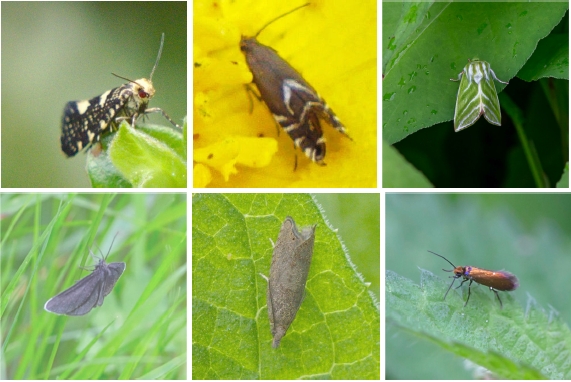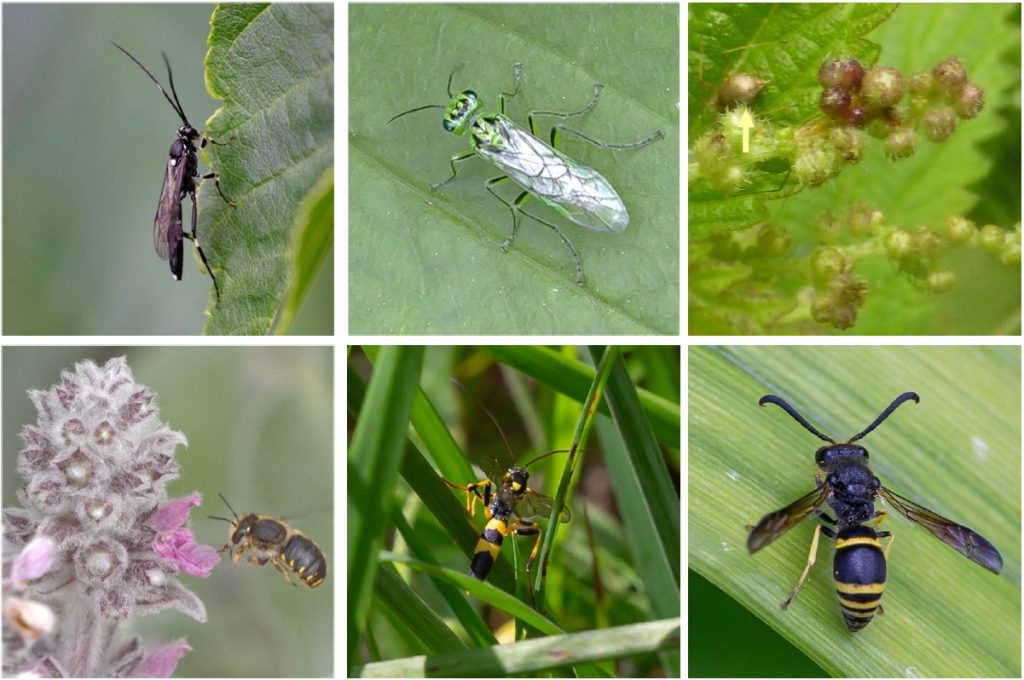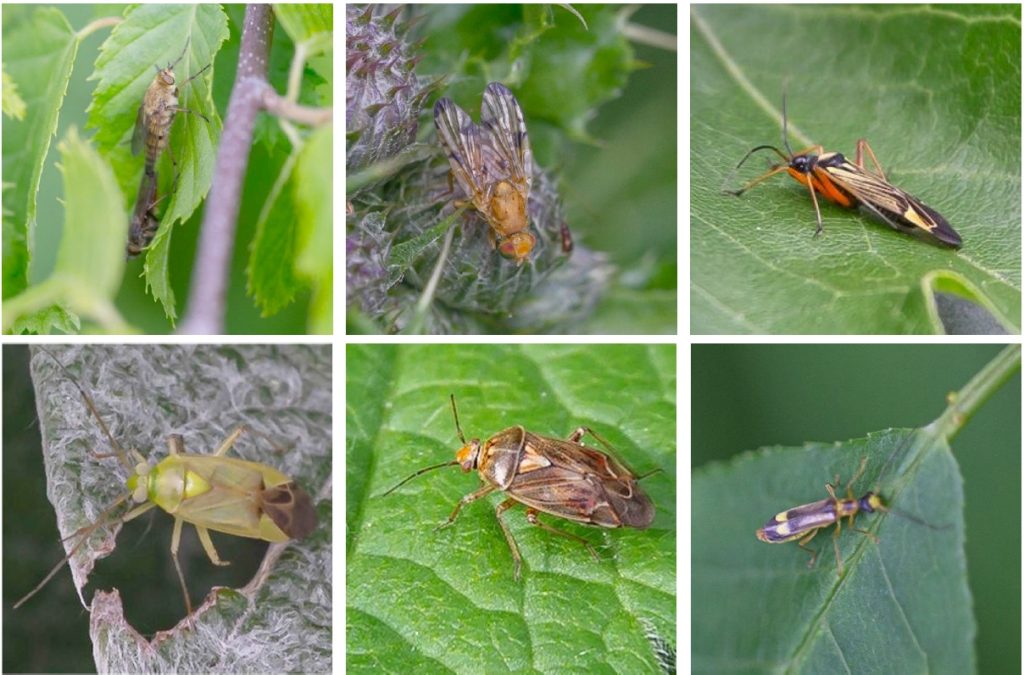
June moths. All new Garden records. Top left, Raspberry Moth (Lampronia corticella), 3 June 2019, photo Ken Dobson. Top centre, Cocksfoot Moth (Glyphipterix simpliciella), 2 June 2019, photo Ken Dobson. Top right, Green Silver-lines (Pseudoips prasinana), 3 June 2019, photo Alan Crawford. Bottom left, Chimney Sweeper (Odezia atrata), 22 June 2019, photo Alan Crawford. Bottom centre, Silver-lined Drill (Dichrorampha plumbagana), 3 June 2019, photo Ken Dobson. Bottom right, Plain Gold (Micropterix calthella), 22 June 2019, photo Ken Dobson.
June 2019 was a showery, often rather chilly month at the Garden for the most part. Total rainfall at the Garden was 78.8 mm — much less than some other parts of the city. In the west of the city, the Gogarbank weather station recorded almost 45 mm of torrential rain in just a few hours during a thunderstorm on 24th which caused flash floods in western parts of the city. On the same day the Botanics recorded ‘only’ 16 mm of rain. There was another thunderstorm on 29th. Total sunshine recorded at the Garden was 188.2 hours, with at least some sun being recorded on about two-thirds of days. The highest temperature was 21.3°C while the lowest maximum recorded was 12.1°C and the lowest minimum 5.5°C.
Despite this cool weather it was an extremely good month from the wildlife recording point of view. No less than 21 species were added to the Garden’s list, taking it from 1,092 to 1,113. Several additional species remained unidentified at the time of writing and most if not all of them will no doubt swell the list even further if and when they can be named. The 21 species definitely identified comprised six moths, three hymenopterans (a sawfly and two parasitic wasps), two true flies, six bugs, two beetles and two spiders.
Birds: Thirty-nine bird species were recorded at RBGE during June 2019. The Garden’s first Swallow was seen on 13th, with another on 24th (presumably before the afternoon’s downpour) while Swifts were recorded on eight dates from 15th onwards. As in May, Black-headed Gulls and Kingfisher were absent, no doubt still breeding elsewhere. The month, however, brought several records of confirmed breeding within the Garden, including Great Spotted Woodpecker, Nuthatch and Collared Dove among other species — the latter particularly welcome since it is some years since the species was even seen in the Garden. No especially unusual sightings were made although a Common Gull was seen on 26th, the first for several years. A Mistle Thrush on 6th was out-of-season unless resident. The complete list of 39 species recorded during June 2019 was: Blackbird, Blackcap, Blue Tit, Bullfinch, Carrion Crow, Chaffinch, Chiffchaff, Coal Tit, Collared Dove, Common Gull, Dunnock, Feral Pigeon, Goldcrest, Goldfinch, Great Spotted Woodpecker, Great Tit, Greenfinch, Grey Heron, Herring Gull, Jackdaw, Lesser Black-backed Gull, Long-tailed Tit, Magpie, Mallard, Mistle Thrush, Moorhen, Nuthatch, Oystercatcher, Robin, Siskin, Song Thrush, Sparrowhawk, Stock Dove, Swallow, Swift, Tawny Owl, Tree Creeper, Wood Pigeon, Wren.
Mammals and amphibians: Palmate Newts were reported on four dates (2nd, 3rd, 6th and 28th) while a Common Frog was also seen on 2nd. Badger activity was evident on several dates.

Insects and other invertebrates: Ten butterfly species were recorded in the Garden during June. 2019 has been a major invasion year for the Painted Lady, thousands of which have been seen throughout the UK as far north as Shetland; in the Garden, the first record was on 9th and they have been seen on most days since. On 27th, around fifty were seen together near the Botanic Cottage. Apparently the collective noun for such a mass gathering is a ‘kaleidoscope of butterflies’. The last such mass invasion of this migratory butterfly was in 2009. Other ‘vanessids’ recorded were a tatty Peacock on 6th, Red Admirals on numerous dates, a Comma on 10th and a Small Tortoiseshell on 20th. Other species recorded were Speckled Wood on ten dates throughout the month, Small White on six, and single records of Green-veined White (2nd), Large White (30th) and Meadow Brown (26th). It was a good month for day-flying moths. Of the fourteen species seen, six were new Garden records: Cocksfoot Moth (2nd), Raspberry Moth, Green Silver-lines and Silver-lined Drill (all 3rd) and Chimney Sweeper and Plain Gold, both on 22nd. A possible White-Barred Gold on the weekend of 22nd/23rd would be a seventh new Garden record but still awaits definite identification at the time of publication. Other species seen were the year’s second Fairy Longhorn (2nd), the migratory Diamond-back on 15th and 22nd, Silver-ground Carpet (9th, 18th), Brimstone Moth (9th), a Hummingbird Hawkmoth on 27th by the Cottage with the fifty Painted Ladies, Common Marble (29th) and Gold-ribbon Argent (30th). The leaf mines of Common Slender and Apple Leaf-miner were also recorded. Among hymenopteran sightings, Green Sawfly (1st), the black-and-white ichneumon Achaius oratorius (22nd), and the braconid wasp Aphidius microlophii (20th), which parasitises Common Nettle Aphid, were all new Garden records. Wool Carder Bees were seen from 28th onwards, much later than the last few years although they might have been present, though missed, on earlier dates. Other records of interest were Turnip Sawfly (several more sightings, throughout June), Bugle Sawfly (three dates), Ashy Mining-bee (3rd), Chocolate Mining-bee (18th), Tree Wasp and the ichneumon Amblyteles armatorius (both 16th) and the wasp Ancistroceros scoticus (17th). No Odonata (dragonflies and damselflies) were seen during June. Twelve hoverfly taxa were recording during the month. The most notable were White-clubbed Hoverfly Scaeva pyrastri (9th), Glass-winged Syrphus (1st and 9th), and the year’s first sightings of Dead-head Hoverfly Myathropa florea (1st, 5th, 7th, 18th) and Migrant Hoverfly Eupeodes corollae (9th, 18th). Marmalade Hoverfly was recorded on 12 dates throughout the month. Two more flies were added to the Garden list, both on 22nd: Two-spot Stiletto and Large Fruit-fly. The former was originally believed to be Common Stiletto but the original photograph shows two separate dark spots on the front of the head. Short-palped Crane-fly was recorded on 30th and Tachina fera on three dates. New Garden records of bugs included three mirid bugs: Miris striatus (Fine-streaked Bugkin) and Harpocera thoracica (both on 1st) and Neolygus contaminatus on 16th, and three aphids: Common Nettle Aphid (18th, 20th), Common Oak Aphid (18th) and Small Hazel Aphid (20th). There were numerous records of Gorse Shield-bug, Parent Bug (with nymphs on 30th), Forest Shield-bug, Hawthorn Shield-bug (6th and 21st), Birch Shield Bug and Birch Catkin Bug. Two flower bug species were found: Anthocoris nemoralis (3rd) and Common Flower Bug A. nemorum (6th). The most intriguing beetle species to be added to the Garden list for a long time was the carrion beetle Necrodes littoralis, which was attracted by the foul scent of the Titan Arum (Amorphophallus titanum) that flowered again in the glasshouses in June 2019 (overnight, 23rd/24th). June’s other new Garden beetle record was the striking black and yellow soldier beetle, Malthinus flaveolus on 30th. Two other soldier beetles, Grey Sailor Beetle Cantharis nigricans (3rd, 5th) and the reddish brown Cantharis livida (8th, 10th) were also recorded. Garden Click Beetle was recorded on at least eight different days. Rosemary Beetle was found on lavender by the Botanic Cottage on 6th. Common Pollen Beetle was in flowers near the East Gate on 6th while Brachypterus glaber frequented stinging nettle inflorescences (3rd, 18th). A weevil, Phyllobius maculicornis, was on the hornbeam hedge in the Queen Mother’s Garden (1st, 6th, 8th, 9th, 17th), and Figwort Weevil adults and especially larvae were present on its hosts all month. Four other different weevils remain unidentified; some could be additional Garden records. Ladybird records included 7-spot on 14 dates (larva also seen on 20th), Pine and 2-spot on seven dates each, 10-spot on 15th and 16th, and a Cream-spot larva on 20th. Two lacewing species were recorded: Hemerobius micans on 3rd and Chrysopa perla on 9th. An as yet unidentified globular springtail will almost certainly represent an additional new Garden record if it can be named. Selimus vittatus (1st) was the first of June’s two new spider records. The other one was Cucumber Spider Araniella opisthographa (6th, with prey) — its close relative A. cucurbitina is already on the Garden’s list. The galls of nine gall-mites were found. Garden Snail was seen on 6th, 17th and 28th. Finally, a New Zealand Flatworm was recorded in paving near the Botanic Cottage on 3rd.

June flies, bugs and beetles. All new Garden records. Top left, Two-spot Stiletto Fly (Thereva bipunctata), 22 June 2019, photo Alan Crawford. Top centre, Large Fruit-fly (Xyphosia miliaria), 22 June 2019, photo Alan Crawford. Top right, Fine-streaked Bugkin (Miris striatus), 1 June 2019, photo Alan Crawford. Bottom left, Neolygus contaminatus, 16 June 2019, photo Alan Crawford. Bottom centre, Harpocera thoracica, 1 June 2019, photo Alan Crawford. Bottom right, soldier beetle Malthinus flaveolus, 30 June 2019, photo Alan Crawford.
